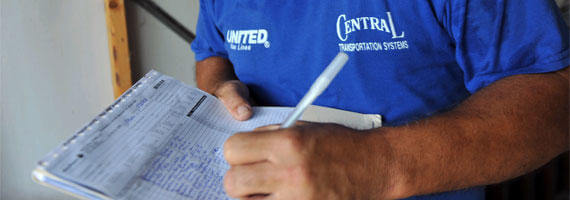“Don't you love how we have this impression that our stuff is safe in some Ft Knox storage outfit, when in fact it is a big non-temperature controlled warehouse with everyone's stuff just separated with ropes and free reign of workers walking back and forth...I've been in one myself, so I know... it's no wonder ...”
I read this comment on this post last month and knew there was only one thing I could do in response: see military household good storage for myself. “Surely what she said could not possibly be the norm,” I thought. “Surely, there must be some explanation.”
And it is for that reason I bring you “PCS Storage: Exposed.” Are you ready?
That commenter was right. Sort of. Mostly her general points were right, but the impression they gave me was not. And I have a video to prove it.
I shot this video last week at Thompson Moving and Storage here at Fort Campbell. David Taylor, the warehouse manager, was kind enough to give me the nickel tour.
Wasn’t that the most exciting and scandalous thing you’ve seen all year? Yep, that’s what I thought, too.
Here's how the whole thing works:
Household goods (or HHG) storage is governed by a set of rules enforced by Military Surface Deployment and Distribution Command, which has regional managers across the country conducting surprise inspections on contractors throughout the year. Temporary storage, or how things are stored in between pick-up and delivery during stateside moves, and long term storage differ slightly but follow some of the same basic rules, said James Fomby, one of the regional managers.
- Goods in temporary storage for more than 72 business hours must be put either in vaults or stored on wrapped pallets at least two inches off the floor. Long term storage is treated much the same way, with some of the key differences being that pallets are not used, all the goods are wrapped in paper and any stuffed furniture, like couches, has to be wrapped and put on shelves individually.
- HHG can be left on the floor for 72 business hours at a time during a “staging” period. This allows the movers to drop-off the stuff to the storage facility where it is checked-off against the inventory list and the people who will be delivering it to move it back into their truck while inventorying it again.
- While the warehouses are not temperature controlled, they must be controlled for humidity levels.
See? Not nearly as scary as we feared. According to Blythe Wilson, a specialist with surface command (and whose voice you can hear in the first part of the video), the storage set-up in our video is the norm. During a move my stuff, generally speaking, lives in crates unless it is in the process of being moved in or out.
Where the ropes separating different family’s things come into play, said Taylor, the manager in the video, is mostly during peak moving season. His company may have five, six or more pick-ups and deliveries on one day during that time. To make those moves happen and get you your stuff, he said, he has to lay it out side-by-side in the warehouse so the delivery trucks can get it out. And while there are instances of stuff getting lost in the shuffle or misplaced, he said his team is extremely careful to make sure the lot numbers – and things labeled with them – don’t get mixed-up.
Yes, there is room for error and, yes, you can see how things may get mixed-up during this process, he said. But by and large, properly labeled stuff gets where it is supposed to go. Disgruntled employees roaming around, taking their pain out on your things, are likely few and far between. The biggest key, he said, is in preparation and making sure the movers see and then inventory all of your things before they go on the truck.
And that’s where we get to the sticky part: the labels. (Ah, that was a good pun -- labels are sticky … get it? OK.)
As it turns out, according to the people at Thompson, most moving problems come when things don’t get labeled and put on the inventory like they should. It’s particularly easy for movers, said Taylor, to miss putting stickers on items that don’t fit in boxes or are being moved loose – things like garden tools, ladders, screws to bedroom furniture and many of the items listed in the comments here.
“If it’s something like a broom or mop – garden tools are a big item, something outside or in a corner or something. That’s your more common items that [go missing]” Taylor said.
But it is in companies’ best interest to make sure people get their stuff without destroying it in the process. Unhappy MilFams can very easily mean the end of government business for a moving or storage company, Blyth Wilson pointed out. And since many of the moving contractors are small, local businesses who rely almost entirely on military moves for their bread and butter, keeping us military folks happy is a very high priority, Thompson said.
“At my house all of my pictures belong to me – I don’t borrow them out of storage,” said owner Ricky Thomas. “We don’t use the jet skis, we don’t mow our lawns with the lawn mowers … When it comes down to it, taking care of people’s things is a business decision. The most important thing is that the member is happy.”










